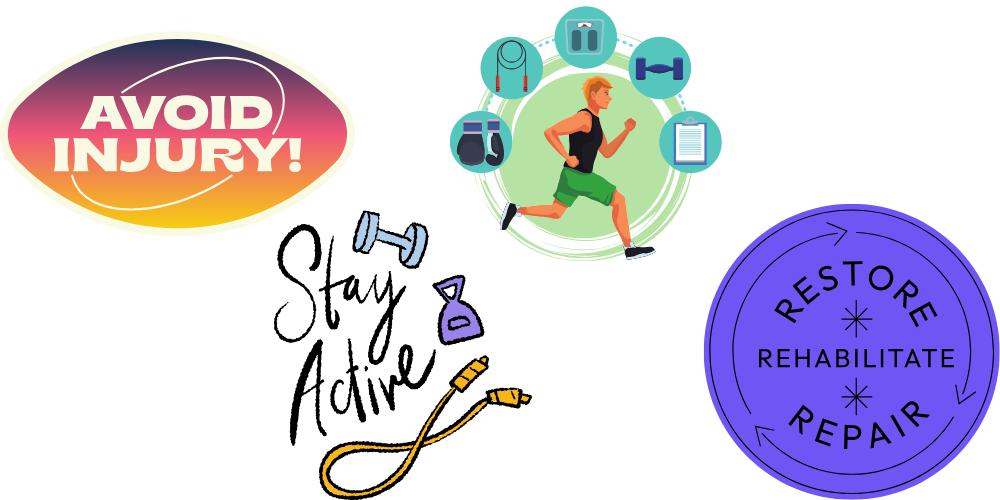Fitness is truly a journey full of rewards that benefit just as much physically — and mentally. Of course, it is also worth recognising the possibility of injuries during that journey. Whether you’re an experienced athlete or a newbie just starting your fitness journey, knowing how to prevent injury and be safe while working out is super important for longevity in this game. In this blog post, we will explore these crucial elements so that you can learn how to stay protected and bounce back from setbacks.
Injury Prevention: Proactive Measures for a Healthy Fitness Journey
The key to any fitness program is preventing injury. However, by being proactive, you can reduce your chances of sustaining an injury and keep the exercise experience going strong! Here are some key strategies:
1. Warm-up and Cool-down: Do not ever take a warm-up and cool down lightly. A dynamic warm-up is designed to increase blood flow, muscle temperature and joint mobility prior to activity. On the flip side, a rest period lets your body come back to its naturally relaxed state and decreases bouts of muscle soreness & stiffness as well.
2. Proper Form and Technique: Make sure you are using proper form or technique on exercises. Incorrect form can put too much strain on your joints and muscles, ultimately raising the odds of getting hurt. Let a fitness professional help you with the proper technique.
3. Gradual Progression: Don\’t try to be an overachiever right from the start. Build up the extent, length, and measure of your exercises over time to give yourself an opportunity to acclimate. Doing too much will cause overuse injuries and no progress.
4. Listen to Your Body: Pay attention to any pain or discomfort you experience during exercise. Pushing through pain can exacerbate an injury. Rest, modify your workout, or seek medical advice if needed.
5. Proper Nutrition and Hydration: Fueling your body with the right foods and drinking enough water will go a long way toward performance and injury prevention. Adequate nutrition supports muscle recovery and repair, while hydration maintains joint lubrication and overall bodily function.
6. Rest and Recovery: Give your body adequate time to rest and recover between workouts. Overtraining also depresses your immune system and makes you more susceptible to injury. Incorporate rest days into your fitness schedule and prioritise quality sleep.
Injury Rehabilitation: The Road to Recovery
Despite your best efforts, injuries can sometimes occur. In such cases, proper rehabilitation is vital for a complete and safe recovery. Here\’s what you need to know:
1. Seek Professional Guidance: If you get hurt, see a doctor or rehab professional! From their physical therapy clinic, they can provide an accurate type of injury diagnosis and then a tailor-made habit-building (rehab) plan.
2. RICE Protocol: In the immediate aftermath of an injury, follow the RICE protocol:
- Rest: Avoid activities that aggravate the injury.
- Ice: Apply ice packs to the injured area to reduce inflammation and pain.
- Compression: Use compression bandages to minimise swelling.
- Elevation: Elevate the injured area above your heart to reduce swelling.
3. Adherence to Rehabilitation Plan: Diligently follow the rehabilitation plan prescribed by your healthcare professional. It may involve specific exercises, stretches, and modalities to restore strength, flexibility, and function.
4. Gradual Return to Activity: Avoid rushing back into your previous activity levels. Gradually increase your activity level as your body heals and regains strength. Your healthcare professional can guide you on a safe return-to-activity plan.
5. Patience and Persistence: Rehabilitation takes time and effort. Be patient and persistent with your recovery process. Celebrate small milestones and focus on the long-term goal of regaining full function.
Conclusion
Prehab and rehab are just as important in order to have a successful fitness (the new trendy word for fitness journey, which I made up). You\’ll need to follow a periodised strength training program, which will reduce your risk of injury while ensuring that if an injury is inevitable, it\’s as mild and easily managed as possible. But you know what they say: fitness is a marathon, not a sprint. Treat your body right, and it will pay you back in spades.
Disclaimer
This blog is purely intended as information and should not be taken as medical advice. Consult a qualified healthcare professional anytime before beginning any type of new fitness program or if you have any concerns regarding an injury.


